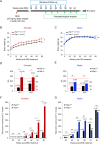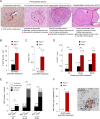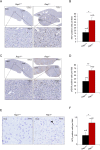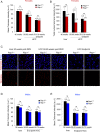Mice lacking RAP1 show early onset and higher rates of DEN-induced hepatocellular carcinomas in female mice
- PMID: 30307978
- PMCID: PMC6187989
- DOI: 10.1371/journal.pone.0204909
Mice lacking RAP1 show early onset and higher rates of DEN-induced hepatocellular carcinomas in female mice
Abstract
RAP1, a component of the telomere-protective shelterin complex, has been shown to have both telomeric and non-telomeric roles. In the liver, RAP1 is involved in the regulation of metabolic transcriptional programs. RAP1-deficient mice develop obesity and hepatic steatosis, these phenotypes being more severe in females than in males. As hepatic steatosis and obesity have been related to increased liver cancer in mice and humans, we set out to address whether RAP1 deficiency resulted in increased liver cancer upon chemical liver carcinogenesis. We found that Rap1-/- females were more susceptible to DEN-induced liver damage and hepatocellular carcinoma (HCC). DEN-treated Rap1-/- female livers showed an earlier onset of both premalignant and malignant liver lesions, which were characterized by increased abundance of γH2AX-positive cells, increased proliferation and shorter telomeres. These findings highlight an important role for RAP1 in protection from liver damage and liver cancer.
Conflict of interest statement
The authors have declared that no competing interests exist.
Figures





Similar articles
-
Constitutive Notch2 signaling induces hepatic tumors in mice.Hepatology. 2013 Apr;57(4):1607-19. doi: 10.1002/hep.26165. Epub 2013 Mar 14. Hepatology. 2013. PMID: 23175466
-
Cell expression patterns of CD147 in N-diethylnitrosamine/phenobarbital-induced mouse hepatocellular carcinoma.J Mol Histol. 2015 Feb;46(1):79-91. doi: 10.1007/s10735-014-9602-3. Epub 2014 Dec 2. J Mol Histol. 2015. PMID: 25447507
-
Hepatic loss of miR-122 predisposes mice to hepatobiliary cyst and hepatocellular carcinoma upon diethylnitrosamine exposure.Am J Pathol. 2013 Dec;183(6):1719-1730. doi: 10.1016/j.ajpath.2013.08.004. Epub 2013 Oct 8. Am J Pathol. 2013. PMID: 24113455 Free PMC article.
-
Chronic administration of diethylnitrosamine to induce hepatocarcinogenesis and to evaluate its synergistic effect with other hepatotoxins in mice.Toxicol Appl Pharmacol. 2019 Sep 1;378:114611. doi: 10.1016/j.taap.2019.114611. Epub 2019 Jun 6. Toxicol Appl Pharmacol. 2019. PMID: 31176654
-
RAP1/TERF2IP-A Multifunctional Player in Cancer Development.Cancers (Basel). 2021 Nov 27;13(23):5970. doi: 10.3390/cancers13235970. Cancers (Basel). 2021. PMID: 34885080 Free PMC article. Review.
Cited by
-
Telomere-dependent and telomere-independent roles of RAP1 in regulating human stem cell homeostasis.Protein Cell. 2019 Sep;10(9):649-667. doi: 10.1007/s13238-019-0610-7. Epub 2019 Feb 22. Protein Cell. 2019. PMID: 30796637 Free PMC article.
-
Telomeres and Telomerase in the Development of Liver Cancer.Cancers (Basel). 2020 Jul 24;12(8):2048. doi: 10.3390/cancers12082048. Cancers (Basel). 2020. PMID: 32722302 Free PMC article. Review.
-
Component Identification of Phenolic Acids in Cell Suspension Cultures of Saussureainvolucrata and Its Mechanism of Anti-Hepatoma Revealed by TMT Quantitative Proteomics.Foods. 2021 Oct 15;10(10):2466. doi: 10.3390/foods10102466. Foods. 2021. PMID: 34681515 Free PMC article.
-
Prediction of liver cancer prognosis based on immune cell marker genes.Front Immunol. 2023 Apr 27;14:1147797. doi: 10.3389/fimmu.2023.1147797. eCollection 2023. Front Immunol. 2023. PMID: 37180166 Free PMC article.
-
Tieing together loose ends: telomere instability in cancer and aging.Mol Oncol. 2022 Sep;16(18):3380-3396. doi: 10.1002/1878-0261.13299. Epub 2022 Aug 16. Mol Oncol. 2022. PMID: 35920280 Free PMC article. Review.
References
-
- Fattovich G, Stroffolini T, Zagni I, Donato F. Hepatocellular carcinoma in cirrhosis: incidence and risk factors. Gastroenterology. 2004;127(5 Suppl 1):S35–50. . - PubMed
Publication types
MeSH terms
Substances
LinkOut - more resources
Full Text Sources
Medical
Molecular Biology Databases
Research Materials

